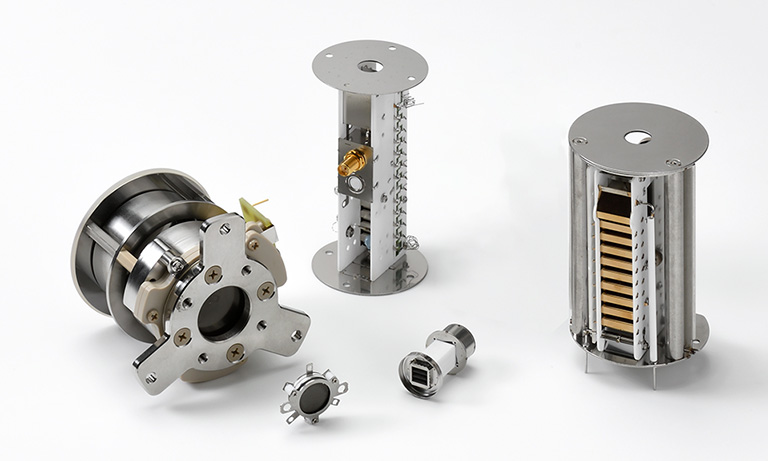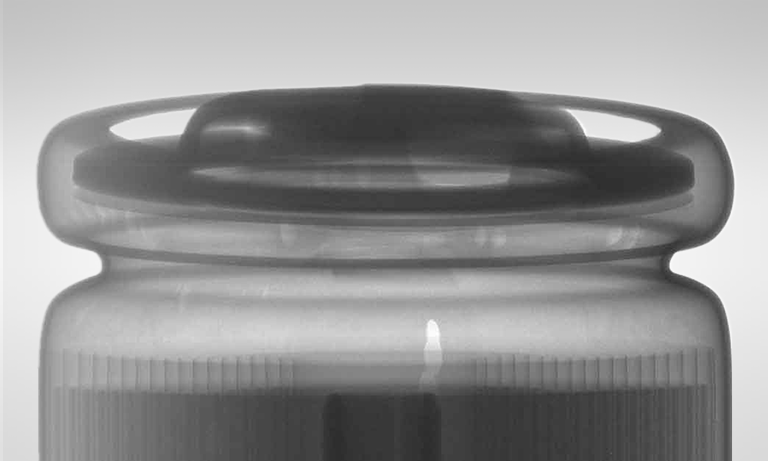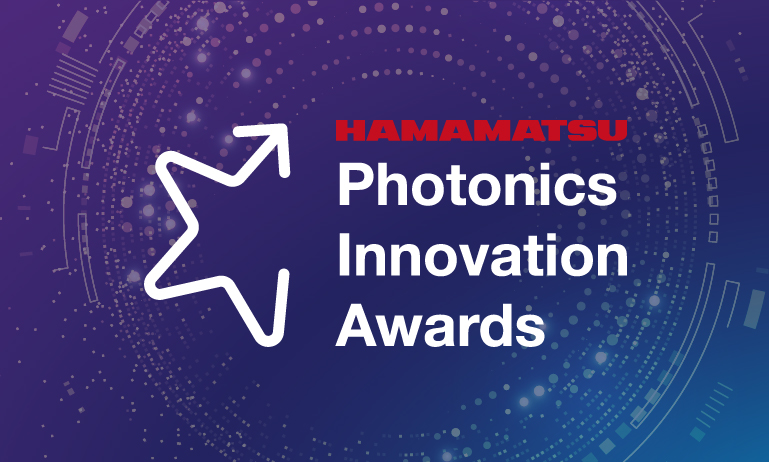United Kingdom (EN)
Select your region or country.
Dynamic point spread function engineering & next generation microscope
Optical microscope and wavefront control
The optical microscopes that we generally handle is composed of optical elements such as lenses and filters, mechanisms and stages for enclosure, and manually or electrically controlled system for observation. There is a trend toward higher functionality and complexity in recent optical microscopes, such as a confocal microscope that scans the laser bright spot with an electromagnetically driven mirror, an aberration-correcting objective lens with a correction ring that can be rotated manually by devising the lens design, and the invention of stimulated emission depletion microscopy (STED), one of the super-resolution microscopes using a donut shape laser beam. Therefore, we have introduced a spatial light phase modulator (LCOS-SLM) in the microscope optical system to perform wavefront control, so that the direction of the light beam and the light intensity distribution can be freely changed, and the optical microscope can be digitally controlled.
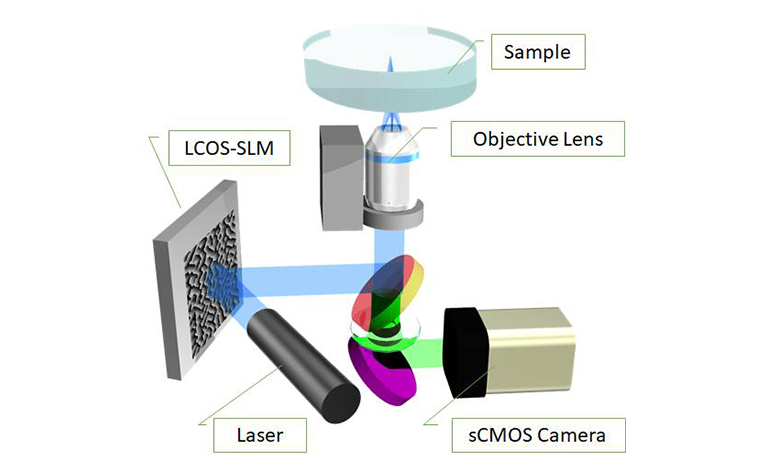
We are focusing on theoretical control and dynamic control by LCOS-SLM of point spread function (PSF), which shows the response characteristics of optical systems to point light sources particularly. To achieve this, both high-precision optical technology, including lens design, and phase control are required. However, we have advanced technology development and applied it to microscopes. We have succeeded in realizing individual or simultaneous multipoints, aberration correction, multifocals, depth of field expansion etc. that were not obtained. In particular, the aberration correction makes it possible to obtain clear images of the deep part of the living body, which has been difficult to observe. Recently, we are studying various PSFs to be applied to mouse brain function measurement, and we are advancing research in collaboration with researchers around the world.
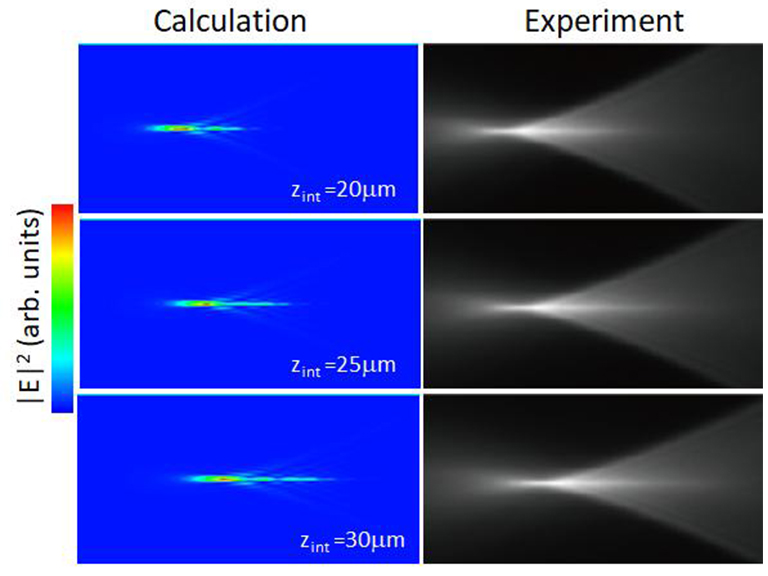
Generation and optical manipulation of higher-order mode light
LCOS-SLM can express arbitrary phase distribution with high accuracy and can generate various special light beams. Taking advantage of this feature, we are researching the generation, measurement, and application of higher-order mode light such as optical vortex using LCOS-SLM. Optical vortices are distributed in a spiral shape around the propagation axis (the figure below: left), so the center of the spiral wavefront (this is called the phase singularity) has zero intensity and a donut-shaped beam pattern. It can be obtained (Figure below: right). Furthermore, there is angular momentum on the orbit of the donut-shaped intensity distribution, and microparticles and molecules of μm to nm size can be rotated by the power of light. Because of these features, it has been attracting attention as a new measurement tool based on the interaction between light and materials and has also been used for optical manipulation and super-resolution microscopic measurements, which have become a hot topic in the Nobel Prize in recent years. We are also working on optical tweezers and have succeeded in realizing optical vortex tweezers that apply high-precision optical vortex generation technology and supply stable torque. We are also researching measurement technology using wavefront sensors to evaluate the generated optical vortex. The optical vortex beam has a phase singularity where the light intensity is zero and the phase cannot be specified. High-order optical vortices have a problem in that it is difficult to identify singular points because the area where the light intensity is almost zero increases. To solve these problems, we proposed a method for detecting singularities with high accuracy and experimentally verified. High-order vortex beams have been reported to have a high ability to penetrate scattering media with conventional Gaussian beams. This measurement technology is expected to be applied to biological measurement in the deep part of the living body with the aim of investigating the distribution and dynamics of phase singularities.

Publications
- Yu Takiguchi, Taro Ando, Yoshiyuki Ohtake, Takashi Inoue, Haruyoshi Toyoda, “Effects of dielectric planar interface on tight focusing coherent beam: direct comparison between observations and vectorial calculation of lateral focal patterns”, Journal of the Optical Society of America A 12/2013; 30(12):2605-10
- Yu Takiguchi, Hisayoshi Takamoto, Masamitsu Kanada, Takashi Inoue, Naoya Matsumoto, Susumu Terakawa, “Numerical Spherical Aberration Correction Method using Spatial Light Modulator under Deep-Part Fluorescence Observation”, Proceedings of SPIE - The International Society for Optical Engineering 02/2014
- Yu Takiguchi, Min-Woong Seo, Keiichiro Kagawa, Hisayoshi Takamoto, Takashi Inoue, Shoji Kawahito and Susumu Terakawa, “Mechanical scanner-less multi-beam confocal microscope with wavefront modulation”, Optical Review 02/2016; 23(2): pp 364–368
- Y. Ohtake, T. Ando, N. Fukuchi, N. Matsumoto, H. Ito, T. Hara, "Universal generation of higher-order multiringed Laguerre-Gaussian beams by using a spatial light modulator," Optics Letters, 32, 11, 1411-1413 (2007).
- N. Matsumoto, T. Ando, T. Inoue, Y. Ohtaka, N. Fukuchi, T. Hara, "Generation of high-quality higher-order Laguerre-Gaussian beams using liquid-crystal-on-silicon spatial light modulators," Journal Optical Society of America A, 25, 7, 1642-1651 (2008).
- T. Ando, Y. Ohtake, N. Matsumoto, T. Inoue, and N. Fukuchi, "Mode purities of Laguerre-Gaussian beams generated via complex-amplitude modulation using phase-only spatial light modulators," Optics Letters, 34, 34-36 (2009).
- T. Ando, N. Matsumoto, Y. Ohtaka, Y. Takiguchi, T. Inoue, "Structure of optical singularities in coaxial superpositions of laguerre-Gaussian modes," Journal of the Optical Society of America A, 27, 12, 2602-2612 (2010).
- T. Otsu, T. Ando, Y. Takiguchi, Y. Ohtake, H. Toyota, and H. Itoh, “Direct evidence for three-dimensional off-axis trapping with single Laguerre-Gaussian beam,” Scientific Reports 4:4579 (2014), doi:10.1038/srep04579.
- Confirmation
-
It looks like you're in the . If this is not your location, please select the correct region or country below.
You're headed to Hamamatsu Photonics website for GB (English). If you want to view an other country's site, the optimized information will be provided by selecting options below.
In order to use this website comfortably, we use cookies. For cookie details please see our cookie policy.
- Cookie Policy
-
This website or its third-party tools use cookies, which are necessary to its functioning and required to achieve the purposes illustrated in this cookie policy. By closing the cookie warning banner, scrolling the page, clicking a link or continuing to browse otherwise, you agree to the use of cookies.
Hamamatsu uses cookies in order to enhance your experience on our website and ensure that our website functions.
You can visit this page at any time to learn more about cookies, get the most up to date information on how we use cookies and manage your cookie settings. We will not use cookies for any purpose other than the ones stated, but please note that we reserve the right to update our cookies.
1. What are cookies?
For modern websites to work according to visitor’s expectations, they need to collect certain basic information about visitors. To do this, a site will create small text files which are placed on visitor’s devices (computer or mobile) - these files are known as cookies when you access a website. Cookies are used in order to make websites function and work efficiently. Cookies are uniquely assigned to each visitor and can only be read by a web server in the domain that issued the cookie to the visitor. Cookies cannot be used to run programs or deliver viruses to a visitor’s device.
Cookies do various jobs which make the visitor’s experience of the internet much smoother and more interactive. For instance, cookies are used to remember the visitor’s preferences on sites they visit often, to remember language preference and to help navigate between pages more efficiently. Much, though not all, of the data collected is anonymous, though some of it is designed to detect browsing patterns and approximate geographical location to improve the visitor experience.
Certain type of cookies may require the data subject’s consent before storing them on the computer.
2. What are the different types of cookies?
This website uses two types of cookies:
- First party cookies. For our website, the first party cookies are controlled and maintained by Hamamatsu. No other parties have access to these cookies.
- Third party cookies. These cookies are implemented by organizations outside Hamamatsu. We do not have access to the data in these cookies, but we use these cookies to improve the overall website experience.
3. How do we use cookies?
This website uses cookies for following purposes:
- Certain cookies are necessary for our website to function. These are strictly necessary cookies and are required to enable website access, support navigation or provide relevant content. These cookies direct you to the correct region or country, and support security and ecommerce. Strictly necessary cookies also enforce your privacy preferences. Without these strictly necessary cookies, much of our website will not function.
- Analytics cookies are used to track website usage. This data enables us to improve our website usability, performance and website administration. In our analytics cookies, we do not store any personal identifying information.
- Functionality cookies. These are used to recognize you when you return to our website. This enables us to personalize our content for you, greet you by name and remember your preferences (for example, your choice of language or region).
- These cookies record your visit to our website, the pages you have visited and the links you have followed. We will use this information to make our website and the advertising displayed on it more relevant to your interests. We may also share this information with third parties for this purpose.
Cookies help us help you. Through the use of cookies, we learn what is important to our visitors and we develop and enhance website content and functionality to support your experience. Much of our website can be accessed if cookies are disabled, however certain website functions may not work. And, we believe your current and future visits will be enhanced if cookies are enabled.
4. Which cookies do we use?
There are two ways to manage cookie preferences.
- You can set your cookie preferences on your device or in your browser.
- You can set your cookie preferences at the website level.
If you don’t want to receive cookies, you can modify your browser so that it notifies you when cookies are sent to it or you can refuse cookies altogether. You can also delete cookies that have already been set.
If you wish to restrict or block web browser cookies which are set on your device then you can do this through your browser settings; the Help function within your browser should tell you how. Alternatively, you may wish to visit www.aboutcookies.org, which contains comprehensive information on how to do this on a wide variety of desktop browsers.
5. What are Internet tags and how do we use them with cookies?
Occasionally, we may use internet tags (also known as action tags, single-pixel GIFs, clear GIFs, invisible GIFs and 1-by-1 GIFs) at this site and may deploy these tags/cookies through a third-party advertising partner or a web analytical service partner which may be located and store the respective information (including your IP-address) in a foreign country. These tags/cookies are placed on both online advertisements that bring users to this site and on different pages of this site. We use this technology to measure the visitors' responses to our sites and the effectiveness of our advertising campaigns (including how many times a page is opened and which information is consulted) as well as to evaluate your use of this website. The third-party partner or the web analytical service partner may be able to collect data about visitors to our and other sites because of these internet tags/cookies, may compose reports regarding the website’s activity for us and may provide further services which are related to the use of the website and the internet. They may provide such information to other parties if there is a legal requirement that they do so, or if they hire the other parties to process information on their behalf.
If you would like more information about web tags and cookies associated with on-line advertising or to opt-out of third-party collection of this information, please visit the Network Advertising Initiative website http://www.networkadvertising.org.
6. Analytics and Advertisement Cookies
We use third-party cookies (such as Google Analytics) to track visitors on our website, to get reports about how visitors use the website and to inform, optimize and serve ads based on someone's past visits to our website.
You may opt-out of Google Analytics cookies by the websites provided by Google:
https://tools.google.com/dlpage/gaoptout?hl=en
As provided in this Privacy Policy (Article 5), you can learn more about opt-out cookies by the website provided by Network Advertising Initiative:
http://www.networkadvertising.org
We inform you that in such case you will not be able to wholly use all functions of our website.
Close











